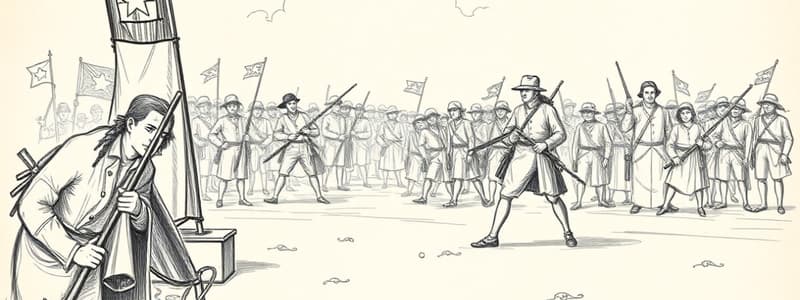Podcast
Questions and Answers
What was the date of the sketch's creation?
What was the date of the sketch's creation?
- September 11, 1777
- August 1777 (correct)
- 1774
- April 2024
Who is attributed as the artist of the sketch?
Who is attributed as the artist of the sketch?
- Thomas Paine
- John Trumbull
- Gilbert Stuart
- Pierre Eugene du Simitiere (correct)
What role did the female followers of the Continental Army primarily serve, as depicted in the sketch?
What role did the female followers of the Continental Army primarily serve, as depicted in the sketch?
- Combatants in battles
- Artists documenting the war
- Support roles such as cooking and medical care (correct)
- Political advisors to generals
What dimensions does the sketch measure?
What dimensions does the sketch measure?
What is the significance of this sketch in terms of historical context?
What is the significance of this sketch in terms of historical context?
What was the initial perception of the drawing's significance before its discovery by Matthew Skic?
What was the initial perception of the drawing's significance before its discovery by Matthew Skic?
Which of the following details about the drawing was crucial in identifying its historical importance?
Which of the following details about the drawing was crucial in identifying its historical importance?
What conclusion did Matthew Skic draw regarding the potential origins of the sketch?
What conclusion did Matthew Skic draw regarding the potential origins of the sketch?
Which item was found on the reverse side of the drawing?
Which item was found on the reverse side of the drawing?
How did Judith Hernstadt acquire the sketch?
How did Judith Hernstadt acquire the sketch?
Flashcards are hidden until you start studying
Study Notes
A Revolutionary War Drawing
- A pen-and-ink drawing of a Revolutionary War scene was found in a New York City apartment.
- The sketch depicts two women and a baby in a horse-drawn carriage, accompanied by six soldiers.
- The sketch was acquired in the mid-1970s by Judith Hernstadt, an avid collector.
- The sketch's significance remained unnoticed for 40 years.
- In 2023, Matthew Skic, a curator at the Museum of the American Revolution, identified the sketch as portraying a Continental Army soldier.
Key Details
- The sketch measures 15 inches by 5 inches (38 cm by 12.7 cm) and is made of paper and ink from the Revolutionary era.
- The drawing depicts a wagon belonging to the North Carolina Brigade of Continental troops, passing through Philadelphia in August 1777.
- It is dated August 1777, just before the Battle of Brandywine (September 11, 1777).
- The artist was Pierre Eugene du Simitiere, a Swiss artist who arrived in Philadelphia in 1774.
- The sketch is one of only two known artworks featuring female followers of the Continental Army.
- The sketch has been donated to the Museum of the American Revolution by Hernstadt.
- The sketch went on public display in April 2024.
Significance of the Sketch
- The sketch provides insight into the daily lives of soldiers in the Continental Army, showcasing both the joyful and difficult aspects of life.
- The sketch offers an unseen perspective by highlighting the role of female support staff in the army.
- This sketch complements existing historical narratives about the Continental Army.
Studying That Suits You
Use AI to generate personalized quizzes and flashcards to suit your learning preferences.




